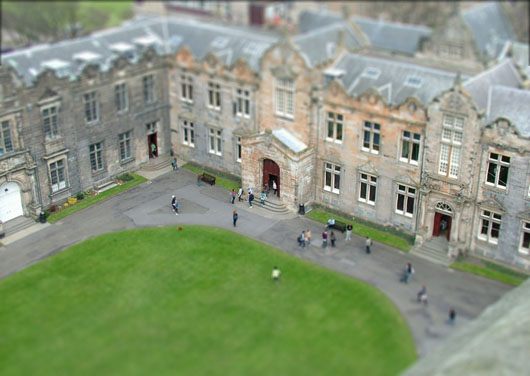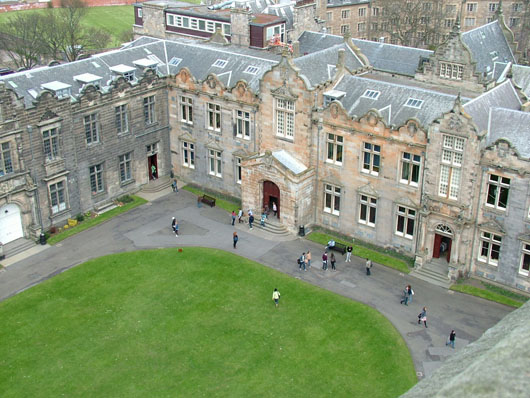Why it’s all a blur

Dr Vishwanath faked miniaturisation of St Salvator’s Quadrangle (original image below).

CSI and the BBC’s new Sherlock Holmes have something in common, and it’s not crime-fighting. Both TV series have used camera trickery to create the illusion of miniature scenes, a phenomenon explained by scientists this month.
A new study into the phenomenon of tilt-shift miniaturisation – where objects are set in a blurred background to make them appear tiny – has been put under the microscope by researchers at the University of St Andrews.
It is the first piece of empirical research to report an important link between retinal blur and the perception of size and distance.
The finding will help scientists as well as photographers understand the phenomenon that has so far puzzled the worlds of visual arts and science.
Psychologist Dr Dhanraj Vishwanath explained, “When we look out into the world, we have a pretty good sense of the distance of objects because the brain has lots of pieces of information it can put together to calculate it.
“The brain uses this information to automatically figure out how big things are out there. The further away an object is, the smaller the ‘image’ it forms on the eye. But the brain allows us see things at their real size by adjusting for changes in image size with its knowledge of distance. That’s why people don’t appear to shrink as they walk away from you.”
However, Dr Vishwanath has found that when looking at a photograph, it’s an entirely different matter. They key to the optical trick lies in the fact that the brain doesn’t have the information it needs about distance and size within a picture.
He explained, “When we look into pictures, the visual part of the brain doesn’t have any information about the distance of objects within the picture. It only knows how far away the picture itself is. It is only because we ‘recognise’ objects in a picture, such as a football player on a pitch, that we mentally guess how far away and how big everything else is.
“What we found during our studies is that the brain can also use the pattern of blur at the eye to calculate distance. If there is a lot of blur, it assumes the object is very close by.”
The blur miniaturisation effect is commonly used in the visual arts and photography, where life-sized locations or objects are manipulated with blur (either during photography or post production) to look like a miniature model. Objects captured to great effect include football stadiums, trains and large cityscapes, such as those featured on the new Sherlock.
Dr Vishwanath continued, “When photographers artificially add blur they trick the visual part of the brain into calculating that the objects in the picture are close up. Since the brain now has some ‘proper’ information about distance in the picture, it doesn’t care what you know – that it is actually a photo of a big object far away – instead, it forces you to see it as closer and smallerlike a toy.”
Many faked-miniature photographs are taken from a high angle to simulate the effect of looking down on tiny buildings, a method used (with painstaking hand manipulation of helicopter footage) in the Harrowdown Hill video by Radiohead’s Thom Yorke.
The opposite trick, making small things look big, is also used by artists such as James Casebere, who carefully photographs a small model of a scene so that it doesn’t have the blur it would normally have, making the scenes appear strangely life size.
Similar effects also occur under other conditions where the brain gets confused about distance, such as when looking out of the window of a plane as it lands.
“Cars and houses look like toys, but then suddenly, just before the plane touches down and you can see the horizon, far away objects look normal again,” Dr Vishwanath explained.
”Our study explains a phenomenon in photography that has been in popular use in the media and visual arts for the last five years or so, and yet until now there has been no systematic scientific explanation for it. However, the effects of blur also have very important implications for how the brain constructs our perception of 3D space, how we interact with it and why we see depth when we look at a flat picture.”
The research is published by the Journal of Vision: www.journalofvision.org/content/10/10/26.abstract
ENDS
Note to Editors
The researcher Dr Dhanraj Vishwanath is available for interview on 01334 462074 or email [email protected].
Note to Picture Editors
Images demonstrating the effect are available from the Press Office – contacts below.
Issued by the Press Office, University of St Andrews
Contact Gayle Cook, Senior Communications Manager on 01334 467227 / 462529, mobile 07900 050 103, or email [email protected]
Ref: Blur 270910
View the latest University press releases at www.st-andrews.ac.uk
Category University news